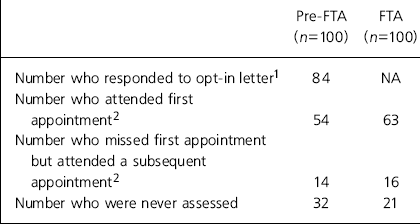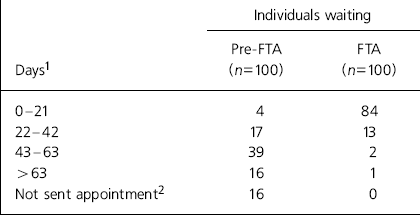In England, community mental health teams (CMHTs) are usually the gatekeepers for non-urgent referrals of new patients to specialist mental health services. This paper describes the impact on waiting times and non-attendance rates of re-engineering the referral and assessment process in one CMHT in South-East London.
Method
The CMHT comprises two consultant psychiatrists, each working with a junior doctor and with a shared clinical team comprising one associate specialist, 5.2 whole time equivalent community psychiatric nurses, 1.5 social workers, 1 occupational therapist and 2.4 therapy staff. The team serves a catchment population of 78 000 with a mixed social demography and a mean Mental Illness Needs Index (Reference Glover, Robin and EmamiGlover et al, 1998) score of 100.5 (indicating an above average level of social deprivation).
The change in the referral and assessment process was made initially just for the area served by one of the consultants.
In the past, there was a ‘traditional’ common referral system. The majority of new referrals to the CMHT were from local general practitioners. All such referrals which did not require an immediate response were discussed at a weekly referrals meeting. A decision was made, on the basis of the information in the referral letter, about whether the client should be assessed by a psychiatrist or by another member of the team (who would be a social worker, a mental health nurse or an occupational therapist). In either case, the individual was sent an opt-in letter which asked them to telephone to make an appointment. Only those who responded were given an appointment. Those allocated to a psychiatrist were sent an out-patient appointment for the next available new patient slot; those allocated to another member of the team were sent an appointment to be seen by a ‘ duty worker’. Assessments were by a single professional and there was no forum for a multiprofessional discussion following the assessment.
The team was concerned about the long delays in the processing of referrals and, after a close examination of the old system to identify where the delays were occurring, proposed a new approach.
Fast-track assessment (FTA) is a simpler system. As before, all referrals are discussed at the weekly referral meeting. However, all individuals, except emergencies, are now sent a fixed appointment for the next FTA clinic. The clinic is programmed for a morning every other week. The FTA clinic is staffed by four or five members of the team (the consultant psychiatrist, the associate specialist and two or three non-medical professionals). Individuals are booked into one of three time slots at 45 min intervals and assessed by a single professional. This gives the FTA clinic a potential capacity of between 12 and 15 new patient slots a fortnight. Each assessment is allocated 45 min and is supported by a structured ‘core assessment’ pro forma and a simple risk assessment checklist. All staff who have conducted assessments meet at the end of the clinic for between 30 and 60 min, depending on the number of assessments made, to discuss all referrals, both those assessed and those that did not attend, and to agree future actions. The person who conducted the assessment is responsible for ensuring that agreed actions are taken and for communicating the results of the assessment to the referrer.
Evaluation of the FTA clinic
The new clinic was evaluated using clinical audit. The principal audit standard was that patients referred as new patients should be given an appointment date for a first assessment that is within 3 weeks of a referral having been received by the CMHT. In addition, the impact of the new FTA clinic on attendance rates was measured.
The audit sample consisted of two cohorts of 100 consecutive new referrals, before and after the introduction of the FTA clinic in September 2002, which had been considered at the CMHT referrals’ meeting and deemed to require non-urgent assessment. The referral letters, case notes and computerised data for these referrals were retrieved to ascertain the date the referral was received, the date of the first appointment offered and the date of the first appointment attended.
Results
Table 1 shows the outcome of the referral process. Overall, 79% of all referrals processed through the FTA clinic resulted in the patient being assessed, compared with 68% before its introduction (χ2=3.1; P=0.08). The non-attendance rate for the first appointment offered was similar before and after the introduction of the FTA clinic (36 v. 37% of those sent a first appointment), as was the number who missed a first appointment but then attended a subsequent one (17 v. 16% of those sent a first appointment).
Table 1. Referral outcome before and after the introduction of fast-track assessment (FTA)

| Pre-FTA (n=100) | FTA (n=100) | |
|---|---|---|
| Number who responded to opt-in letter1 | 84 | NA |
| Number who attended first appointment2 | 54 | 63 |
| Number who missed first appointment but attended a subsequent appointment2 | 14 | 16 |
| Number who were never assessed | 32 | 21 |
Before the FTA clinic was introduced, the mean time interval between the referral being received and the date of the first appointment offered was 55 days (s.d.=51). After the introduction of the FTA, it was 18 days (s.d.=9). This difference was highly significant (t=78; P<0.001). As Table 2 shows the audit standard, that patients referred should be given an appointment date within 3 weeks of receipt of a referral, was met for 4% of referrals before FTA and 84% after its introduction (χ2 with Yates correction=126; P<0.001).
Table 2. Waiting times before and after the introduction of fast-track assessment (FTA)

| Individuals waiting | ||
|---|---|---|
| Days1 | Pre-FTA (n=100) | FTA (n=100) |
| 0-21 | 4 | 84 |
| 22-42 | 17 | 13 |
| 43-63 | 39 | 2 |
| > 63 | 16 | 1 |
| Not sent appointment2 | 16 | 0 |
The mean interval between the date of receipt of referral and the date the individual attended an assessment was 71 days (s.d.=90) before the introduction of FTA (n=68 participants) and 26 days (s.d.=27) after its introduction (n=79 participants). This difference was also highly significant (t=77; P<0.001).
Discussion
The two cohorts might not be directly comparable because the availability of rapid assessments in the FTA clinic might have influenced the decision as to which referrals require urgent assessment and so should bypass the routine assessment system. The impression of those who manage the referrals process is that the rapid response time of the FTA has raised the threshold for deeming a referral urgent.
With this caveat in mind, a simple re-engineering of the referral and assessment process has resulted in a reduction by two-thirds in the interval between both referral and first appointment offered and between referral and actual assessment for those who attended. Two factors account for most of this difference. First, the FTA system is simpler and more efficient; with appointment letters being sent on the day of the referral meeting. It is virtually free of the administrative problems of the previous, three-stage system (referral meeting-opt-in letter-appointment) caused by oversights, staff sickness, delayed post and missed phone calls. Second, the dedicated FTA clinic does not have the problems of capacity of the previous system, which depended on the availability of slots in busy out-patient clinics and duty diaries. The team's collective responsibility for the FTA clinic means that appointments are never cancelled because of leave or sickness. The number of staff available to make assessments can be adjusted to match fluctuations in demand.
The FTA clinic has other benefits over the more traditional system that it replaced:
-
• All assessments are now discussed by a multidisciplinary team.
-
• Decisions about referrals for future care are taken, and often implemented, immediately following assessment.
-
• Before the introduction of the FTA clinic, the decision about whether to allocate to a psychiatrist or another member of the team was based solely on the information in the referral letter and was often arbitrary. This is now mediated by the discussion of cases, between psychiatrists and other team members, at the end of the FTA clinic.
-
• Any action to be taken for patients who fail to attend appointments is decided by the multidisciplinary team immediately following the clinic. Under the old system, this would have been discussed at the next referral meeting.
-
• The duty system is now free of routine assessments of new referrals.
-
• Staff benefit from the informal training that occurs by discussing assessments with colleagues.
The cost of the FTA clinic, in terms of staff time, is probably no greater than that of the more traditional system that it replaced. The additional 30-60 min spent at the end of the FTA clinic discussing those assessed is probably more than offset by savings in time spent in informal communications about people referred and assessed under the old system.
The introduction of the FTA clinic has not improved the new patient non-attendance rate, as it is normally measured, i.e. the proportion of patients who attend the first appointment that is offered. However, a higher proportion of referrals resulted in an assessment being made at a first or subsequent appointment (however, this difference did not quite reach statistical significance). This might be due to the mental health service's more rapid response to the referral. Also, it is possible that some people who would not have responded to an opt-in letter under the old system did respond to being sent a fixed appointment.
The FTA clinic is not a radical new concept and it is highly likely that in CMHTs around the country there are models for processing new referrals that are at least as effective in minimising waiting times. The principal purpose of this paper is to illustrate how a simple redesign of a core system within a CMHT can improve the quality of a care process at little or no additional cost.





eLetters
No eLetters have been published for this article.